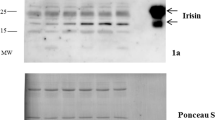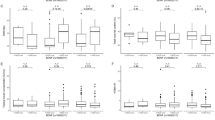Abstract
Objective and subjects: To investigate the role of resistin gene variants on the adiposity and metabolic changes observed in response to a 100-day overfeeding protocol conducted with 12 pairs of monozygotic twins.
Measurements: Body-fat measurements included hydrodensitometry and abdominal fat from computed tomography. Plasma glucose and insulin during fasting and in response to an oral glucose tolerance test (OGTT) were assayed. A 4.2 MJ test meal was consumed, after which calorimetric measurements were performed for 240 min.
Results: Respiratory quotient (RQ) decreased (P=0.001) more in AA/AG than in GG subjects of the IVS2+181G>A polymorphism after the caloric surplus and the significance persisted when correction for multiple testing was performed. Total abdominal (P=0.027) and visceral (P=0.004) fat increased more in TC than in TT subjects of the IVS2+39C>T polymorphism. In response to overfeeding, glucose area under the curve during the OGTT showed a slight decrease (P=0.031) in the TC while it increased in TT subjects. OGTT insulin area tended to increase less (P=0.055) in TC than in TT subjects. After overfeeding, fasting insulin was lower in TC than in TT subjects (P=0.010). In addition, TC subjects experienced more decrease in RQ than TT subjects (P=0.034).
Conclusion: The IVS2+181G>A variant was associated with the changes in RQ in response to overfeeding. The IVS2+39C>T polymorphism was associated with overfeeding-induced changes in abdominal visceral fat, OGTT glucose area and RQ. The results suggest that sequence variation in the resistin gene is involved in the adaptation to chronic positive energy balance.
This is a preview of subscription content, access via your institution
Access options
Subscribe to this journal
Receive 12 print issues and online access
$259.00 per year
only $21.58 per issue
Buy this article
- Purchase on Springer Link
- Instant access to full article PDF
Prices may be subject to local taxes which are calculated during checkout
Similar content being viewed by others
References
Behnke AR &, Wilmore JH (1974). Evaluation and Regulation of Body Build and Composition. Englewood Cliffs, NJ: Prentice-Hall
Bouchard C et al (1990). The response to long-term overfeeding in identical twins. N. Engl. J. Med 322, 1477–1482.
Engert JC et al (2002). 5′ flanking variants of resistin are associated with obesity. Diabetes 51, 1629–1634.
Hartman HB, Hu X, Tyler KX, Dalal CK &, Lazar MA (2002). Mechanisms regulating adipocyte expression of resistin. J. Biol. Chem. 277, 19754–19761.
Haugen F, Jorgensen A, Drevon CA &, Trayhurn P (2001). Inhibition by insulin of resistin gene expression in 3T3-L1 adipocytes. FEBS Lett. 507, 105–108.
Janke J, Engeli S, Gorzelniak K, Luft FC &, Sharma AM (2002). Resistin gene expression in human adipocytes is not related to insulin resistance. Obes. Res. 10, 1–5.
Juan CC et al (2001). Suppressed gene expression of adipocyte resistin in an insulin-resistant rat model probably by elevated free fatty acids. Biochem. Biophys. Res. Commun. 289, 1328–1333.
Katzmarzyk PT, Perusse L, Tremblay A &, Bouchard C (2000). No association between resting metabolic rate or respiratory exchange ratio and subsequent changes in body mass and fatness: 5-1/2 year follow-up of the Quebec family study. Eur. J. Clin. Nutr. 54, 610–614.
Kim KH, Lee K, Moon YS &, Sul HS (2001). A cysteine-rich adipose tissue-specific secretory factor inhibits adipocyte differentiation. J. Biol. Chem. 276, 11252–11256.
Le Lay S et al (2001). Decreased resistin expression in mice with different sensitivities to a high-fat diet. Biochem. Biophys. Res. Commun. 289, 564–567.
Levy JR, Davenport B, Clore JN &, Stevens W (2002). Lipid metabolism and resistin gene expression in insulin-resistant Fischer 344 rats. Am. J. Physiol Endocrinol. Metab. 282, E626–E633.
Li J, Yu X, Pan W &, Unger RH (2002). Gene expression profile of rat adipose tissue at the onset of high-fat-diet obesity. Am. J. Physiol Endocrinol. Metab 282, E1334–E1341.
Ma X, Warram JH, Trischitta V &, Doria A (2002). Genetic variants at the resistin locus and risk of type 2 diabetes in Caucasians. J. Clin. Endocrinol. Metab 87, 4407–4410.
McTernan CL et al (2002a). Resistin, central obesity, and type 2 diabetes. Lancet 359, 46–47.
McTernan PG et al (2002b). Increased resistin gene and protein expression in human abdominal adipose tissue. J. Clin. Endocrinol. Metab. 87, 2407.
Moore GB et al (2001). Differential regulation of adipocytokine mRNAs by rosiglitazone in db/db mice. Biochem. Biophys. Res. Commun. 286, 735–741.
Nadeau A &, Morissette, J (1973). A new simple method of linear transformation of the standard curve in the radioimmunological assay of insulin. Union Med. Can. 102, 566–569.
Nagaev I &, Smith U (2001). Insulin resistance and type 2 diabetes are not related to resistin expression in human fat cells or skeletal muscle. Biochem. Biophys. Res. Commun. 285, 561–564.
Neitzel H (1986). A routine method for the establishment of permanent growing lymphoblastoid cell lines. Hum. Genet. 73, 320–326.
Nolan JJ, Ludvik B, Beerdsen P, Joyce M &, Olefsky J (1994). Improvement in glucose tolerance and insulin resistance in obese subjects treated with troglitazone. N. Engl. J. Med. 331, 1188–1193.
Oppert JM et al (1995). Plasma glucose, insulin, and glucagon before and after long-term overfeeding in identical twins. Metabolism 44, 96–105.
Osawa H et al (2002). Systematic search for single nucleotide polymorphisms in the resistin gene: the absence of evidence for the association of three identified single nucleotide polymorphisms with Japanese type 2 diabetes. Diabetes 51, 863–866.
Pizzuti A et al (2002). An ATG repeat in the 3′-untranslated region of the human resistin gene is associated with a decreased risk of insulin resistance. J. Clin. Endocrinol. Metab. 87, 4403–4406.
Richterich R &, Dauwalder H (1971). Determination of plasma glucose by hexokinase-glucose-6-phosphate dehydrogenase method. Schweiz. Med. Wochenschr. 101, 615–618.
Sentinelli F et al (2002). Human resistin gene, obesity, and type 2 diabetes: mutation analysis and population study. Diabetes 51, 860–862.
Siri WE (1956). The gross composition of the body. Adv. Biol. Med. Phys. 4, 239–280.
Sjostrom L, Kvist H, Cederblad A &, Tylen U (1986). Determination of total adipose tissue and body fat in women by computed tomography, 40K, and tritium. Am. J. Physiol 250, E736–E745.
Steppan CM &, Lazar MA (2002). Resistin and obesity-associated insulin resistance. Trends Endocrinol. Metab 13, 18–23.
Steppan CM et al (2001a). The hormone resistin links obesity to diabetes. Nature 409, 307–312.
Steppan CM et al (2001b). A family of tissue-specific resistin-like molecules. Proc. Natl. Acad. Sci. USA 98, 502–506.
Tremblay A, Despres JP, Theriault G, Fournier G &, Bouchard C (1992). Overfeeding and energy expenditure in humans. Am. J. Clin. Nutr. 56, 857–862.
Wang H, Chu WS, Hemphill C &, Elbein SC (2002). Human resistin gene: molecular scanning and evaluation of association with insulin sensitivity and type 2 diabetes in Caucasians. J. Clin. Endocrinol. Metab 87, 2520–2524.
Way JM et al (2001). Adipose tissue resistin expression is severely suppressed in obesity and stimulated by peroxisome proliferator-activated receptor gamma agonists. J. Biol. Chem. 276, 25651–25653.
Weyer C et al (2000). Energy expenditure, fat oxidation, and body weight regulation: a study of metabolic adaptation to long-term weight change. J. Clin. Endocrinol. Metab 85, 1087–1094.
Acknowledgements
We are indebted to Jacques Bouillon, Suzie Hamel, Brigitte Zément, Maryse Lebrun, Martine Marcotte, Monique Chagnon, Josée Lapointe, Henri Bessette, Gilles Bouchard, Heidi Häikiö and Serge Carbonneau for their contributions to this study. Special thanks to Guy Fournier and Dr Germain Thériault for their role in the management of the study. Gratitude is expressed to Dr Andre Nadeau and the staff of the Diabetes Research Unit for the glucose and insulin assays. Supported in part by a grant (DK 34624) from the National Institutes of Health, by the Medical Council of the Academy of Finland and the Finnish Foundation for Cardiovascular Research. C Bouchard is supported in part by the George A Bray Chair in Nutrition.
Author information
Authors and Affiliations
Contributions
Guarantor: C Bouchard.
Corresponding author
Rights and permissions
About this article
Cite this article
Ukkola, O., Antero Kesäniemi, Y., Tremblay, A. et al. Two variants in the resistin gene and the response to long-term overfeeding. Eur J Clin Nutr 58, 654–659 (2004). https://doi.org/10.1038/sj.ejcn.1601861
Received:
Revised:
Accepted:
Published:
Issue Date:
DOI: https://doi.org/10.1038/sj.ejcn.1601861
Keywords
This article is cited by
-
Resistin polymorphisms show associations with obesity, but not with bone parameters in men: results from the Odense Androgen Study
Molecular Biology Reports (2013)
-
The Human Obesity Gene Map: The 2005 Update
Obesity (2006)
-
The Human Obesity Gene Map: The 2004 Update
Obesity Research (2005)



